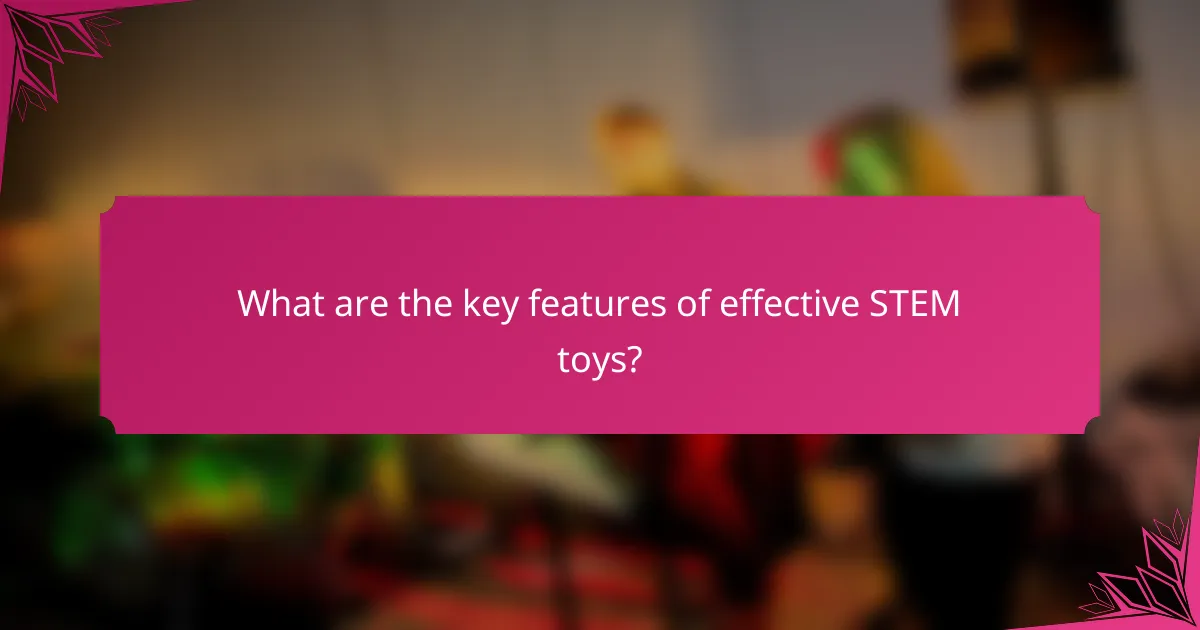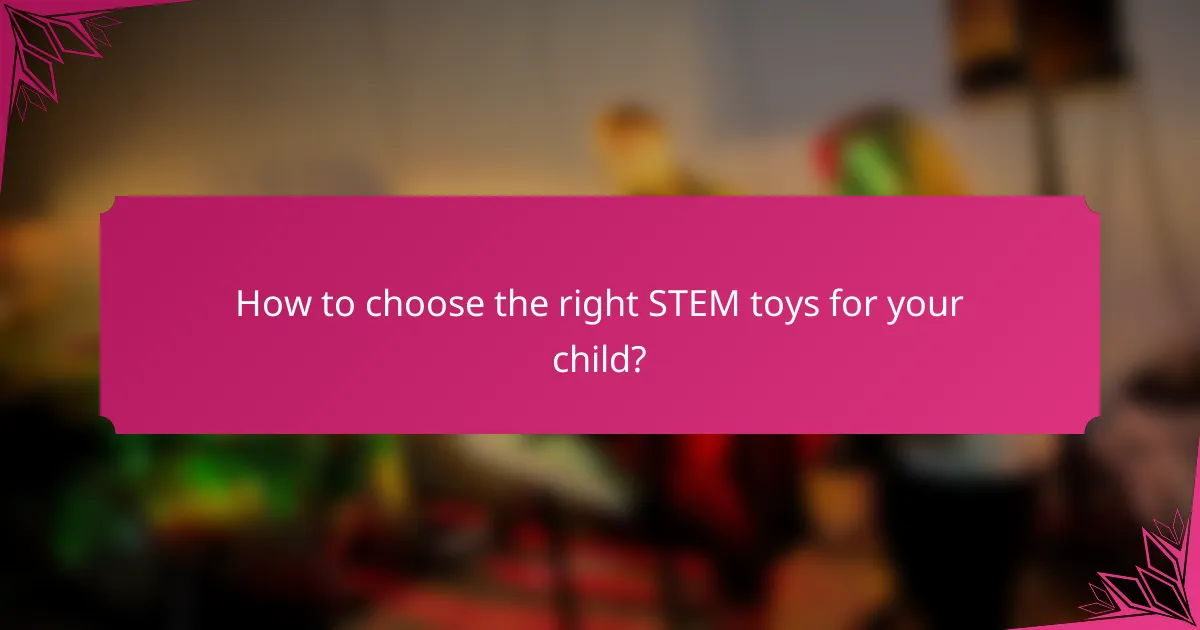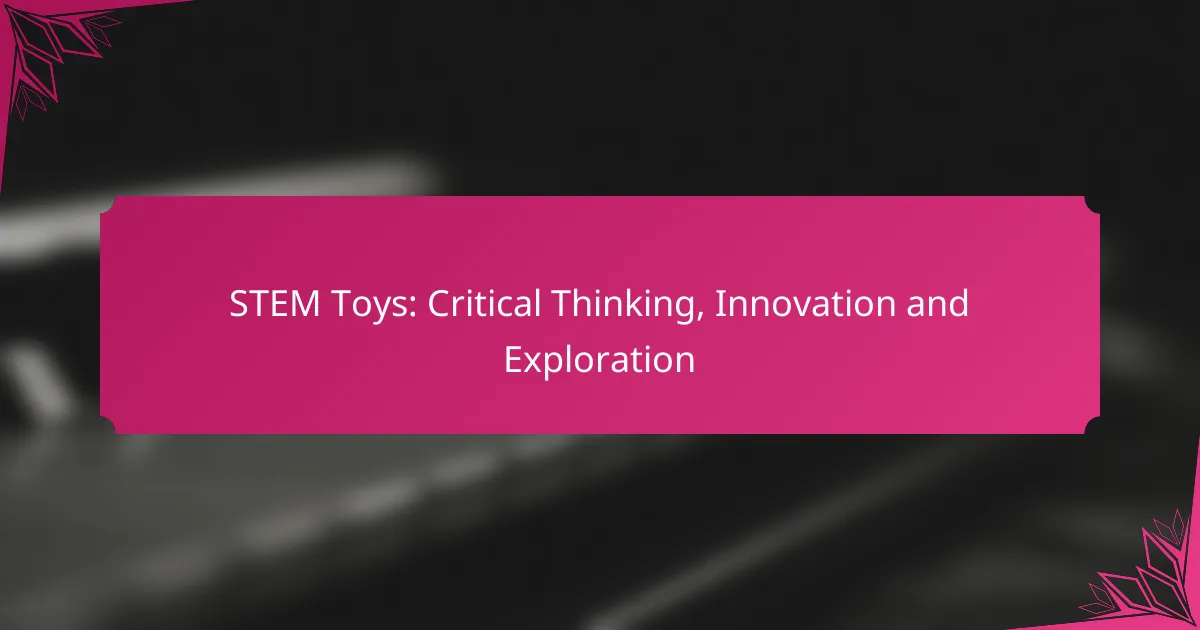STEM toys are essential tools for fostering critical thinking, innovation, and exploration in children. By engaging in hands-on learning experiences, these toys stimulate curiosity and creativity while teaching fundamental concepts in science, technology, engineering, and mathematics. Suitable for various age groups, they adapt to developmental stages, ensuring that every child can benefit from interactive and educational play.

What are the best STEM toys for critical thinking?
The best STEM toys for critical thinking engage children in problem-solving and innovative thinking. These toys encourage exploration and creativity while teaching essential skills in science, technology, engineering, and mathematics.
LEGO Mindstorms EV3
LEGO Mindstorms EV3 is a robotics kit that allows children to build and program their own robots. It combines traditional LEGO building with coding, enabling users to create complex machines that can perform tasks. This hands-on experience fosters critical thinking as kids troubleshoot and refine their designs.
Consider the age and skill level of the child when selecting this kit, as it is best suited for ages 10 and up. The programming interface is user-friendly, but some prior knowledge of coding concepts can enhance the experience.
Osmo Genius Starter Kit
The Osmo Genius Starter Kit integrates physical play with digital learning, using an iPad to create interactive experiences. Children can engage in games that develop skills in math, spelling, and problem-solving. This combination of tactile and digital interaction encourages critical thinking and creativity.
Ideal for children aged 6 to 12, the kit includes various games that adapt to different learning styles. Ensure you have a compatible iPad, as the kit relies on its camera to track physical pieces.
Snap Circuits Jr.
Snap Circuits Jr. is an electronics exploration kit that introduces children to basic circuitry concepts. With snap-together components, kids can create working electronic projects without soldering. This hands-on approach helps develop critical thinking as they experiment with different configurations.
Recommended for ages 8 and up, the kit includes a variety of projects to build, ranging from simple circuits to more complex devices. It’s a great way to spark interest in electronics and engineering.
Kano Computer Kit
The Kano Computer Kit allows children to build their own computer and learn coding through fun challenges. This kit emphasizes creativity and problem-solving as kids assemble hardware and explore software development. It promotes critical thinking by encouraging users to troubleshoot and innovate.
Best suited for ages 6 and up, the kit is designed to be user-friendly, but some adult supervision may be helpful for younger children. The experience can be enhanced by exploring additional coding projects available online.
ThinkFun Gravity Maze
ThinkFun Gravity Maze is a logic game that combines marble runs with spatial reasoning challenges. Players must build a maze that guides a marble to a target, fostering critical thinking and planning skills. The game features various levels of difficulty, making it suitable for a wide age range.
Recommended for ages 8 and up, the game encourages strategic thinking and problem-solving. It’s a great way to engage children in STEM concepts through play, making learning enjoyable and interactive.

How do STEM toys promote innovation?
STEM toys promote innovation by encouraging children to engage in hands-on learning experiences that stimulate their curiosity and critical thinking. These toys often incorporate elements of science, technology, engineering, and mathematics, allowing kids to explore concepts in a fun and interactive way.
Encourages problem-solving skills
STEM toys are designed to present challenges that require children to think critically and devise solutions. For example, building kits may involve constructing a bridge that can hold weight, prompting kids to experiment with different designs and materials. This trial-and-error process enhances their ability to analyze problems and develop effective strategies.
To maximize problem-solving benefits, choose toys that offer varying levels of difficulty. Start with simpler projects and gradually introduce more complex tasks as confidence builds. This approach helps maintain engagement while fostering a growth mindset.
Fosters creativity through open-ended play
Open-ended STEM toys allow children to explore their creativity without rigid instructions. For instance, construction sets that can be assembled in multiple ways encourage imaginative designs and unique creations. This freedom of expression is crucial for developing innovative thinking.
When selecting toys, look for those that do not limit play to a single outcome. Items like art and science kits that blend creativity with experimentation can inspire children to think outside the box and explore new ideas.
Enhances collaboration in group settings
STEM toys often encourage teamwork, making them ideal for group play. Collaborative projects, such as building a robot or conducting a science experiment, require children to communicate, share ideas, and work together towards a common goal. This interaction not only builds social skills but also enhances their ability to innovate collectively.
To promote collaboration, consider toys that are designed for multiple users. Sets that can be expanded or modified easily allow children to contribute their own ideas while learning to appreciate different perspectives. This collaborative approach can lead to richer, more innovative outcomes.

What age groups benefit from STEM toys?
STEM toys are designed to enhance critical thinking, innovation, and exploration across various age groups, making them beneficial for children from preschool through their teenage years. Each age group can engage with these toys in ways that align with their developmental stages and learning needs.
Preschoolers (3-5 years)
Preschoolers benefit from STEM toys that promote basic problem-solving and motor skills. Toys like building blocks, simple puzzles, and interactive learning games encourage exploration and creativity while introducing foundational concepts in science and math.
When selecting STEM toys for this age group, look for options that are colorful, safe, and easy to manipulate. Avoid toys with small parts that could pose choking hazards and focus on those that stimulate imaginative play.
Elementary school children (6-12 years)
Elementary school children can dive deeper into STEM concepts with toys that challenge their reasoning and analytical skills. Kits for building robots, science experiments, and coding games are excellent choices that foster a hands-on approach to learning.
Consider toys that allow for collaborative play, as teamwork can enhance social skills while tackling STEM challenges. Look for products that align with educational standards, ensuring they provide a structured learning experience that complements school curricula.
Teens (13-18 years)
Teens benefit from more complex STEM toys that encourage critical thinking and innovation. Advanced robotics kits, programming software, and engineering challenges can help them apply theoretical knowledge in practical ways, preparing them for future academic and career pursuits.
When choosing STEM toys for teenagers, focus on those that offer real-world applications and opportunities for project-based learning. Encourage participation in competitions or clubs that utilize these toys, as they can enhance skills and provide valuable experiences in teamwork and leadership.

What are the key features of effective STEM toys?
Effective STEM toys are designed to promote critical thinking, innovation, and exploration through engaging and educational play. Key features include hands-on learning experiences, integration of technology, and adaptability for different skill levels.
Hands-on learning experiences
Hands-on learning experiences are crucial for effective STEM toys as they allow children to engage directly with materials and concepts. This tactile interaction fosters deeper understanding and retention of knowledge. For example, building kits that require assembly encourage problem-solving and creativity.
When selecting STEM toys, look for those that provide opportunities for experimentation and exploration. Toys that allow children to create, modify, and test their ideas can significantly enhance their learning experience.
Integration of technology
Integration of technology in STEM toys can enhance engagement and provide real-world applications of scientific principles. Many modern STEM toys incorporate coding, robotics, or interactive software that allows children to learn through play. For instance, programmable robots can teach basic coding skills while offering a fun and interactive experience.
Consider toys that connect with apps or online platforms, as these can offer additional resources, challenges, and community engagement. However, ensure that the technology is age-appropriate and complements the learning objectives rather than distracts from them.
Adaptability for different skill levels
Effective STEM toys should be adaptable to cater to various skill levels, ensuring that all children can benefit from them. Toys that offer multiple complexity levels or adjustable difficulty can keep children engaged as they grow and develop their skills. For example, a building set might include simple structures for beginners and more complex designs for advanced users.
When choosing STEM toys, look for those that allow for incremental learning. This adaptability helps prevent frustration and encourages continued exploration, making the learning process enjoyable for children of all ages and abilities.

How to choose the right STEM toys for your child?
Selecting the right STEM toys involves understanding your child’s interests, ensuring safety, and evaluating educational benefits. By considering these factors, you can choose toys that promote critical thinking, innovation, and exploration effectively.
Assess interests and learning styles
Begin by identifying what subjects excite your child, whether it’s science, technology, engineering, or mathematics. Children often have unique learning styles; some may prefer hands-on activities, while others thrive with visual or auditory learning.
Engage your child in discussions about their favorite subjects or activities. For instance, if they enjoy building, look for construction sets or robotics kits that align with their interests.
Consider safety and age appropriateness
Safety is paramount when selecting STEM toys. Always check for age recommendations on packaging to ensure the toy is suitable for your child’s developmental stage. Look for toys that comply with safety standards, such as ASTM or EN71, to minimize risks.
Additionally, consider the materials used in the toys. Non-toxic and durable materials are preferable, especially for younger children who may put toys in their mouths. Avoid toys with small parts for toddlers to prevent choking hazards.
Evaluate educational value and reviews
Research the educational value of the STEM toys you are considering. Look for toys that encourage problem-solving, critical thinking, and creativity. Many toys come with guides or activities that enhance learning experiences.
Check online reviews and ratings from other parents to gauge the effectiveness and enjoyment of the toys. Websites like Amazon or educational toy retailers often provide insights into how well a toy engages children and supports learning objectives.

What are the benefits of STEM toys in education?
STEM toys enhance education by fostering critical thinking, innovation, and exploration among students. These toys encourage hands-on learning experiences that develop problem-solving skills and creativity.
Improves engagement in learning
STEM toys significantly improve engagement by making learning interactive and enjoyable. When students manipulate physical objects or engage in experiments, they are more likely to retain information and stay focused on the task at hand.
For instance, building kits that require assembling parts to create a functioning model can captivate students’ attention. This hands-on approach not only makes learning fun but also allows students to see the real-world applications of their studies.
To maximize engagement, choose toys that align with students’ interests and skill levels. Avoid overly complex kits for younger learners; instead, opt for simpler projects that gradually increase in difficulty to maintain motivation and curiosity.
